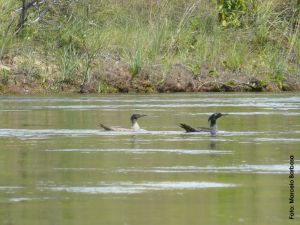

The Cerrado biome is the third on birds diversity, a total of 837 species (SILVA 1995). Recent studies have increased this figure to 856 species (SILVA & SANTOS, 2005) and, more recently, Pinheiro & Dorn (2009) in addition eight species, numbering a total of 864 birds species for Cerrado. 90.7% breed in the biome, 51.8% from this amount dependent on forest environment; 27.4% dependent on open areas and 20.8% live both in forests and in open areas, the remaining 3.1 % are visitors from North America and 12.5% of visitors from southern South America Despite the low rate of endemism, only 3.4% are referred to as Cerrado endemic species (MARN & GARCIA, 2005).
Some places where different groups of endemic species have restricted occurrence along the biome, were recognized as centers of endemism: the plain of the Araguaia River, the valley of the Paranã River and the Chain of the Espinhaço Mountain (SILVA 1997, SILVA & BATES, 2002).
Cerrado has a high richness of amphibians and reptiles species, being comparable to the herpetofauna of the Amazon, when expressed proportionally to the size of each biome (COLLI & BASTOS, 2002). However, its herpetofauna is the least known of all the Brazilian biomes (COSTA et al., 2007). Despite these knowledge gaps, it was recorded for the Cerrado biome 10 species of turtles, 5 species of alligators, 15 species of amphisbaena, 47 species of lizards, 103 species of snakes and 113 species of amphibians. A study in the Cerrado area of southern Maranhão showed a greater similarity of species with areas geographically closer and similar climatic and edaphic (soil) conditions (BARRETO et al., 2007).
With respect to the fauna of lizards, a relatively recent study (NOGUEIRA, 2006) increased to 73 the number of lizard species in the biome. The endemism of the Cerrado herpetofauna is considerable: 53% of amphisbaena are endemic (Amphisbaena anaemariae, A. miringoera, A. neglecta, A. sanctaeritae, A. silvestrii, A. talisiae, Bronia kraoh, Cercelophia sp. Cercelophia Novi and sp. November II), 26% of lizards (Haplocercus spinosus, Anolis meridionalis, Tropidurus itambere, T. montanus, Coledactylus brachystoma, Kentropyx paulensis, K. vanzoi, Bachia Bresslau, B. scolecoides, Bachia sp. Micrablepharus Nov and atticolus) and 28% of the amphibian (Bufo ocellatus, Colostethus goianus, Epipedobates braccatus, Hyla alvarengai, H. anataliasiasi, H. biobeba, H. cipoensis, H. nanuzae, H. pseudopseudis, H. rubicundula, H. saxicola, H. sazimae, H. tritaeniata ,Phasmahyla jandaia, Phyllomedusa centralis, Scinax canastrensis, S. centralis, S. machadoi, S. maracaya, Barycholos savegei, Leptodactylus camaquara, L. cunicularis, L. jolyi, L. tapiti, Odontophyrus moratoi, O. salvatori, Physalaemus deimaticus, P. evangelistai, Proceratophrys cururu, P.goyana, Pseudopaludicola mineira, Chismocleis centralis) are also endemic (COLLI, 2007)
Each of the Cerrado watersheds has its own ichthyological fauna. The distribution patterns of ichthyological species are related to physical and biotic factors that act at different levels of scale, segment and habitats of rivers within each watershed. However, the knowledge on the river basins ichthyofauna of Cerrado is quite discrepant, with the Parnaíba river basin the least well known. Although the main channel of each river basin and its tributaries have been fairly listed, the small rivers and smaller tributaries are still scarcely known.
The Araguaia-Tocantins basin that is the richest in species, while the Rio São Francisco presents the average richness and Parnaíba is relatively poor, when considering the current state of knowledge. The richness of species in each Cerrado basin varies from 350 species in the Araguaia-Tocantins basin, 153 in São Francisco river and 95 in Parnaíba river. In order of importance stands out the Charadriiformes (catfish), present in all the watersheds of the target area. The presence of endemism within each river basin involves the presence of geographical barriers such as waterfalls that separate the great river section or positioning of the fauna in the water body, whether rising or mouth. Besides these conditions, there are still endemism related to fish that live in temporary ponds, thus very vulnerable to changes in environment (RIBEIRO, 2007).
The Cerrado mammals are the third richest in the country, featuring 194 species of land mammals, 30 families and nine orders. The bats are the most diverse with 81 species. It is estimated that 41% of Cerrado species belong to the order Chiroptera (AGUIAR et al.), Followed by rodents, with 51 species. A total of 45 species can be considered medium or large size (weighing more than 1kg).
In Cerrado biome 19 species of endemic mammals are found, relatively low compared to other groups. The low number of endemic species are due to the fact that the Cerrado shares most of its species with the adjacent biome (MARINHO-FILHO, 2007). In this context, the gallery forests play a very important role, allowing the movement of mammals within and between adjacent biome. In a biogeographical perspective, CARMIGNOTTO (2004) suggested a pattern of distribution of small mammals in five faunal regions. Another peculiarity of mammals is related to the distribution of wealth, being higher in open areas of Cerrado (MACHADO et al., 2008).